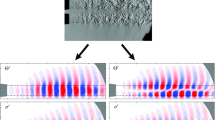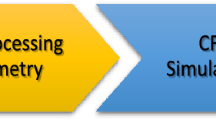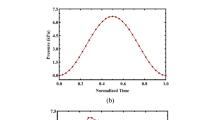Abstract
Hemodynamic forces within the human carotid artery are well known to play a key role in the initiation and progression of vascular diseases such as atherosclerosis. The degree and extent of the disease largely depends on the prevailing three-dimensional flow structure and wall shear stress (WSS) distribution. This work presents tomographic PIV (Tomo-PIV) measurements of the flow structure and WSS in a physiologically accurate model of the human carotid artery bifurcation. The vascular geometry is reconstructed from patient-specific data and reproduced in a transparent flow phantom to demonstrate the feasibility of Tomo-PIV in a complex three-dimensional geometry. Tomographic reconstruction is performed with the multiplicative line-of-sight (MLOS) estimation and simultaneous multiplicative algebraic reconstruction (SMART) technique. The implemented methodology is validated by comparing the results with Stereo-PIV measurements in the same facility. Using a steady flow assumption, the measurement error and RMS uncertainty are directly inferred from the measured velocity field. It is shown that the measurement uncertainty increases for increasing light sheet thickness and increasing velocity gradients, which are largest near the vessel walls. For a typical volume depth of 6 mm (or 256 pixel), the analysis indicates that the velocity derived from 3D cross-correlation can be measured within ±2% of the maximum velocity (or ±0.2 pixel) near the center of the vessel and within ±5% (±0.6 pixel) near the vessel wall. The technique is then applied to acquire 3D-3C velocity field data at multiple axial locations within the carotid artery model, which are combined to yield the flow field and WSS in a volume of approximately 26 mm × 27 mm × 60 mm. Shear stress is computed from the velocity gradient tensor and a method for inferring the WSS distribution on the vessel wall is presented. The results indicate the presence of a complex and three-dimensional flow structure, with regions of flow separation and strong velocity gradients. The WSS distribution is markedly asymmetric confirming a complex swirling flow structure within the vessel. A comparison of the measured WSS with Stereo-PIV data returns an acceptable agreement with some differences in stress magnitude.
















Similar content being viewed by others
Notes
Center of the vessel cross-section refers to the central area of the cross-section where uniform pipe flow exhibits a velocity maxima.
References
Atkinson C, Soria J (2009) An efficient simultaneous reconstruction technique for tomographic particle image velocimetry. Exp Fluids 47(4):553–568
Atkinson CH, Soria J (2007) Algebraic reconstruction techniques for tomographic particle image velocimetry. In: Proceedings of the 16th Australasian fluid mechanics conference, Gold Coast
Bale-Glickman J, Selby K, Saloner D, Savas O (2003) Experimental flow studies in exact-replica phantoms of atherosclerotic carotid bifurcations under steady input conditions. J Biomech Eng 125(1):38–48
Berger SA, Talbot L, Yao LS (1983) Flow in curved pipes. Annu Rev Fluid Mech 15:461–512
Boutsianis E, Guala M, Olgac U, Wildermuth S, Hoyer K, Ventikos Y, Poulikakos D (2009) CFD and PTV steady flow investigation in an anatomically accurate abdominal aortic aneurysm. J Biomech Eng 131(1):011008–011015
Brunette J, Mongrain R, Laurier J, Galaz R, Tardif JC (2008) 3D flow study in a mildly stenotic coronary artery phantom using a whole volume PIV method. Med Eng Phys 30(9):1193–1200
Buchmann N, Jermy M, Nguyen C (2009) Experimental investigation of carotid artery haemodynamics in an anatomically realistic model. Int J Exp Comput Biomech 1(2):172–192
Buchmann NA, Nguyen CV, Wells JC, Jermy M (2008) In-vitro wall shear stress measurements using interfacial particle image velocimetry (IPIV). In: 14th International symposium on applications of laser techniques to fluid mechanics, Lisbon
Burgmann S, Große S, Schröder W, Roggenkamp J, Jansen S, Gräf F, Büsen M (2009) A refractive index-matched facility for fluid–structure interaction studies of pulsatile and oscillating flow in elastic vessels of adjustable compliance. Exp Fluids 47(4–5):865–881
Caro CG (2001) Vascular fluid dynamics and vascular biology and disease. Math Methods Appl Sci 24(17–18):1311–1324
Chatzizisis YS, Coskun AU, Jonas M, Edelman ER, Feldman CL, Stone PH (2007) Role of endothelial shear stress in the natural history of coronary atherosclerosis and vascular remodeling: molecular, cellular, and vascular behavior. J Am Coll Cardiol 49(25):2379–2393
Ding Z, Wang K, Li J, Cong X (2001) Flow field and oscillatory shear stress in a tuning-fork-shaped model of the average human carotid bifurcation. J Biomech 34(12):1555–1562
Elkins CJ, Alley MT (2007) Magnetic resonance velocimetry: applications of magnetic resonance imaging in the measurement of fluid motion. Exp Fluids 43(6):823–858
Elsinga G, Adrian R, van Oudheusden B, Scarano F (2007) Tomographic-PIV investigation of a high reynolds number turbulent boundary layer. In 7th International symposium on particle image velocimetry, Rome
Elsinga G, Westerweel J, Scarano F, Novara M (2009) On the velocity of ghost particles. In: 8th International symposium on particle image velocimetry, Melbourne
Elsinga GE, Scarano F, Wieneke B, van Oudheusden BW (2006) Tomographic particle image velocimetry. Exp Fluids 41(6):933–947
Fischer PF, Loth F, Lee SE, Lee S-W, Smith DS, Bassiouny HS (2007) Simulation of high-reynolds number vascular flows. Comput Methods Appl Mech Eng 196(31–32):3049–3060
Gijsen FJH, Palmen DEM, van der Beek MHE, van de Vosse FN, van Dongen MEH, Janssen JD (1996) Analysis of the axial flow field in stenosed carotid artery bifurcation models—LDA experiments. J Biomech 29:1483–1489
Grant I, Owens E (1990) Confidence interval estimates in piv measurements of turbulent flows. Appl Opt 29(10):1400–1402
Gray JD, Owen I, Escudier MP (2007) Dynamic scaling of unsteady shear-thinning non-newtonian fluid flows in a large-scaled modeld of a distal anastomosis. Exp Fluids 43(4):535–546
Kähler CJ (2004) Investigation of the spatio-temporal flow structure in the buffer region of a turbulent boundary layer by means of multiplane stereo piv. Exp Fluids 36(1):114–130
Keane RD, Adrian RJ (1992) Theory of cross-correlation analysis of piv images. Appl Sci Res 49(3):191–215
Ku DN, Giddens DP, Phillips DJ, Strandness DE (1985) Hemodynamics of the normal human carotid bifurcation: in vitro and in vivo studies. Ultrasound Med Biol 11(1):13–26
Ku DN, Giddens DP, Zarins CK, Glagov S (1985) Pulsatile flow and atherosclerosis in the human carotid bifurcation. Positive correlation between plaque location and low oscillating shear stress. Arterioscler Thromb Vasc Biol 5(3):293–302
Lee S-W, Antiga L, Steinman DA (2009) Correlations among indicators of disturbed flow at the normal carotid bifurcation. J Biomech Eng 131(6):061013–061017
Liepsch D (2002) An introduction to biofluid mechanics—basic models and applications. J Biomech 35(4):415–435
Liepsch D, Pflugbeil G, Matsuo T, Lesniak B (1998) Flow visualization and 1- and 3-D laser-Doppler-anemometer measurements in models of human carotid arteries. Clin Hemorheol Microcirc 18:1–30
Marshall I, Zhao S, Papathanasopouloua P, Hoskinsa P, Xub XY (2004) MRI and CFD studies of pulsatile flow in healthy and stenosed carotid bifurcation models. J Biomech 37:679–687
Michaelis D, Wieneke B (2008) Comparison between tomographic PIV and stereo PIV. In: 14th International symposium on applications of laser techniques to fluid mechanics, Lisbon
Moore S (2008) Computational 3D modelling of hemodynamics in the circle of Willis. VDM Verlag Dr. Mueller, New York
Motomiya M, Karino T (1984) Flow patterns in the human carotid artery bifurcation. Stroke 15(1):50–56
Perktold K, Rappitsch G (1995) Computer simulation of local blood flow and vessel mechanics in a compliant carotid artery bifurcation model. J Biomech 28(7):845–856
Poelma C, Vander Heiden K, Hierck BP, Poelmann RE, Westerweel J (2010) Measurements of the wall shear stress distribution in the outflow tract of an embryonic chicken heart. J Roy Soc Interface 7(42):91–103
Poelma C, Vennemann P, Lindken R, Westerweel J (2008) In vivo blood flow and wall shear stress measurements in the vitelline network. Exp Fluids 45(4):703–713
Prasad AK, Adrian RJ (1993) Stereoscopic particle image velocimetry applied to liquid flows. Exp Fluids 15(1):49–60
Raffel M, Willert CE, Kompenhans J (1998) Particle image velocimetry—a practical guide. Springer, Berlin
Soloff SM, Adrian RJ, Liu ZC (1997) Distortion compensation for generalized stereoscopic particle image velocimetry. Meas Sci Technol 8(12):1441–1454
Soria J (1996) An investigation of the near wake of a circular cylinder using a video-based digital cross-correlation particle image velocimetry technique. Exp Thermal Fluid Sci 12(2):221–233
Soria J, Atkinson C (2008) Towards 3c-3d digital holographic fluid velocity vector field measurement—tomographic digital holographic piv (tomo-hpiv). Meas Sci Technol 19(7):1–12
Spencer AJM (2004) Continuum mechanics. Dover Publications, New York
Taylor CA, Draney MT (2004) Experimental and computational methods in cardiovascular fluid mechanics. Annu Rev Fluid Mech 36:197–231
Traub O, Berk BC (1998) Laminar shear stress: mechanisms by which endothelial cells transduce an atheroprotective force. Arterioscler Thromb Vasc Biol 18(5):677–685
van Doorne CWH, Westerweel J (2007) Measurement of laminar, transitional and turbulent pipe flow using stereoscopic-PIV. Exp Fluids 42(2):259–279
Vennemann P, Lindken R, Westerweel J (2007) In vivo whole-field blood velocity measurement techniques. Exp Fluids 42(4):495–511
Vétel J, Garon A, Pelletier D (2009) Lagrangian coherent structures in the human carotid artery bifurcation. Exp Fluids 46(6):1067–1079
Westerweel J, Scarano F (2005) Universal outlier detection for PIV data. Exp Fluids 39(6):1096–1100
Wieneke B (2008) Volume self-calibration for 3d particle image velocimetry. Exp Fluids 45(4):549–556
Wieneke B, Taylor S (2006) Fat-sheet PIV with computation of full 3D-strain tensor using tomographic reconstruction. In: 13th International symposium on applications of laser techniques to fluid mechanics, Lisbon
Willert CE, Gharib M (1992) Three-dimensional particle imaging with a single camera. Exp Fluids 12(6):353–358
Zarins C, Giddens D, Bharadvaj B, Sottiurai V, Mabon R, Glagov S (1983) Carotid bifurcation atherosclerosis. Quantitative correlation of plaque localization with flow velocity profiles and wall shear stress. Circ Res 53(4):502–514
Zhang J-M, Chua LP, Ghista DN, Zhou T-M, Tan YS (2008) Validation of numerical simulation with piv measurements for two anastomosis models. Med Eng Phys 30(2):226–247
Zhao SZ, Xu XY, Hughes AD, Thom SA, Stanton AV, Ariff B, Long Q (2000) Blood flow and vessel mechanics in a physiologically realistic model of a human carotid arterial bifurcation. J Biomech 33(8):975–984
Author information
Authors and Affiliations
Corresponding author
Rights and permissions
About this article
Cite this article
Buchmann, N.A., Atkinson, C., Jeremy, M.C. et al. Tomographic particle image velocimetry investigation of the flow in a modeled human carotid artery bifurcation. Exp Fluids 50, 1131–1151 (2011). https://doi.org/10.1007/s00348-011-1042-1
Received:
Revised:
Accepted:
Published:
Issue Date:
DOI: https://doi.org/10.1007/s00348-011-1042-1




